War Memorial Stories – WW1
- Private William Appleton,
- Private William Banks,
- Private James Chapman
- Second Lieutenant Frank Dinsdale
- Private John Horn
- Private James Kirkbride
- Second Lieutenant Bernard Lodge
- Driver John Metcalfe
- Rifleman Robert Metcalfe
- Private Thomas Miller
- Private John Mitton
- Company Sergeant Major Robert Mudd
- Private James Preston
- Gunner William Webster
Parts of ‘Wensleydale Remembered’ are reproduced with grateful thanks to the author, Keith Taylor, and publisher, County Books
Private William Appleton, 1st/9th Battalion, Durham Light Infantry
William was born at Dykes Head, Gunnerside in Swaledale in 1896. He was the son of George Appleton and Margaret (nee Coates). From a farming family, William was the third youngest of five sons and two daughters and by the start of the war he was working in the Askrigg district, and he enlisted in the army in Leyburn.
William joined the 9th Battalion, Durham Light Infantry (Gateshead Gurkhas). On 5th November 1916, the battalion was on the Somme near Warlencourt village ready to attack the Butte de Warlencourt, a 40-foot-high conic shaped hill with a quarry in front of it. Initially, they found success as they moved over and round the butte and broke into the German lines beyond. The heavily reinforced enemy counterattacked just after 3:00pm and the battalion was gradually forced back. Desperate hand to hand fighting took place during the afternoon resulting in heavy losses on both sides.
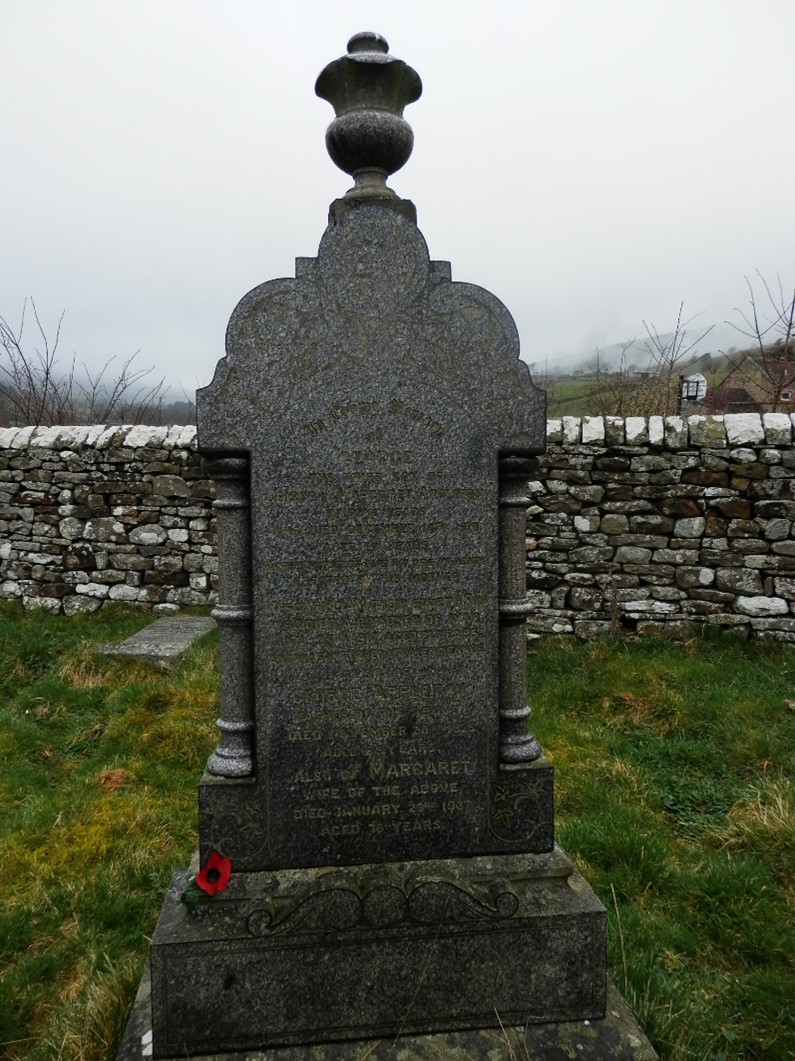
After four hours of sustained bombardment, a final counterattack was launched against the Durhams at 11:00pm. The men of the 9th battalion were overwhelmed, and many died fighting. Others were compelled to surrender and only a handful of men found their way back to the British lines.
Forty-two men were killed that day, 230 wounded and 157 posted missing. One of those missing soldiers was William. He had been wounded in the fighting and had been captured. Nursed by the Germans behind their lines, he died from wounds on 25th January 1917 and was buried by the Germans in grave 1 VC9 in Valenciennes (Saint Roch) Communal Cemetery in France. The cemetery was in German hands throughout the war, and they used it to bury their own dead. William is one of 348 British soldiers also buried there by the Germans.
When word reached the Appleton family, they must have been overwhelmed. William’s older brother, George, had died less than 4 weeks earlier at home in Swaledale and the family were already grieving deeply.
George was laid to rest in Gunnerside Wesleyan Church cemetery, and William and their parents are also remembered on the memorial stone.
William eldest sister Jane (1885-1975) married farmer William Thwaites and other sister, Margaret Ann (1903-1990) married John Reynoldson, a builder and stone mason and the couple lived in Thwaite.
His brothers, James (1889-1928), John (1890-1945) and Albert (1898-1965) all worked in farming and married Louisa Metcalfe, Ethel Dinsdale and Mary Rudkin respectively.
Private William Banks, 1st Battalion, East Yorkshire Regiment
William Banks (senior) married Margaret Annie Bell at St Oswald’s on 1st September 1895 and the couple set up home in Askrigg. The couple had six children, George, William, Alice, Fred, Peggy (Sarah Margaret) and John. William was in business as a grocer and supplier of cattle feed. They had a shop, with a warehouse attached, where their horse and cart were stored.
Both William junior and his elder brother George enlisted in the army. William enlisted i n Richmond and joined the 1st Battalion East Yorkshire Regiment. His brother was in the Northumberland Fusiliers.
n Richmond and joined the 1st Battalion East Yorkshire Regiment. His brother was in the Northumberland Fusiliers.
In September 1918, William’s battalion found themselves taking part in the early stages of the ‘Advance to Victory’. On 10th September they were at Sorel, near Gouzeaucourt, which is between Peronne and Cambrai, ready to attack a series of enemy trenches. The bombardment was delayed, and, in the darkness, the companies found themselves out of position. The attack went in a northerly direction rather than to the northeast. The Germans had anticipated the attack and was fully prepared to meet it. The company on the right met with heavy machine gun fire, and as they had lost their supporting barrage, had to withdraw. The left company went too far left, and the enemy counterattacked and captured 20 men. In addition, one officer and 5 men were killed, and two officers and 36 men were missing. William was one of the dead and his body was buried in grave I.V.D.2 in Gouzeaucourt New British Cemetery. The stained-glass window closest to the main South Door of our church is a memorial to William.
William’s brothers George (1896-1959) and John (1911-1969) worked with their father in the family business. George married Rose Fawcett in 1927 and they lived with their children in Askrigg. Alice Jane (1901-1985) married Henry Russell in 1927 and moved away. Peggy (1908-1981) never married and remained in Askrigg. Fred was born in 1904 and baptised here on 1st May that year. John, born in 1911, is recorded in the 1939 census as being a partner in the business with his father and a special constable.
Private James Chapman, 21st Battalion, Manchester Regiment
James Chapman was the son of Alexander Chapman, a Bainbridge farmer and his wife Mary Wood, who was born in Turton, Lancashire. James was born in 1895 in a farmhouse at Borwins, a cluster of farmsteads near the river Ure between Bainbridge and Hawes. He was baptised in St Oswald’s church on 15th August 1897. By the 1901 census, James was living with his sisters, Elizabeth and Violet and his parents in Sunny Dene in Bainbridge and later that year another sibling, Charles Alexander was born.
James left his family to seek a career in Manchester and at the outbreak of the war in 1914 he was in the employ of Messrs Bagley and Chapman, meat wholesalers. He enlisted in November 1915 and was posted to the Manchester Regiment. He was sent to France in May 1916.

The objective of the Battalion was the capture of the village of Mametz and it was ultimately successful in achieving this aim. However, they had come under very heavy machine gun fire from the entrenched German soldiers and many of the surviving soldiers described the battle for Mametz as a ‘vision of hell’. Amongst the many casualties was James, struck down in the frightening hail of bullets and shellfire on 1st July, less than 6 weeks after he left England. His body was never recovered, and he is commemorated on the Thiepval Memorial on the Somme.
James was the first soldier in the parish to have died in the conflict. At the end of July, a large congregation of attended a memorial service at St. Oswald’s Church led by Rev Squibb.
Back at home, Alexander and Mary died in 1935 and 1930 respectively. James’ brother Charles had taken over his uncle James’ business as a grocer and dealer and in the 1939 census he was living in Bainbridge with both his sisters who remained unmarried. Charles died later that year on 4th November aged just 38. Elizabeth (1890-1954) married garage proprietor Herbert Callender in 1942 and Violet (1898-1956) married local stone mason John Outhwaite Metcalfe in 1949.
Second Lieutenant Frank Dinsdale, 12th Battalion York & Lancashire Regiment
Frank was born at Litherskew, a small farming settlement close to Sedbusk in High Abbotside. His father, James, was a farmer and he had married Sarah Thornborrow from Brough in Westmoreland in 1876. Frank was one of their 15 children, some who were older and some who were younger.
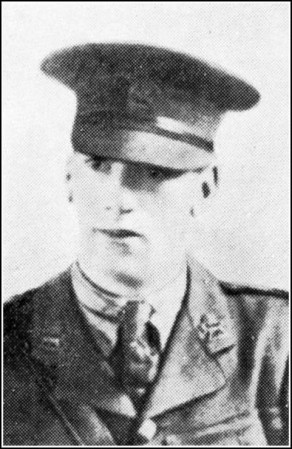 Frank was not destined for a farming life and after leaving Yorebridge Grammar School he attended Garforth college and then Leeds University. By this time his family were now farming at Shaw Cote. When WW1 broke out Frank was a member of the Leeds University Officer Training Corps, receiving his Commission in September 1915 with the rank of second Lieutenant, the 12th battalion York and Lancaster regiment. He went out to France in June 1916.
Frank was not destined for a farming life and after leaving Yorebridge Grammar School he attended Garforth college and then Leeds University. By this time his family were now farming at Shaw Cote. When WW1 broke out Frank was a member of the Leeds University Officer Training Corps, receiving his Commission in September 1915 with the rank of second Lieutenant, the 12th battalion York and Lancaster regiment. He went out to France in June 1916.
On June the 5th the battalion moved to Gezaincourt, where they practised assembling in the trenches ready for the forthcoming engagement. At 9:00pm on 30th June they marched to assembly trenches near Courcelles, where tea was issued to the men. The battalion was no sooner in position opposite the German positions when the enemy bombardment began with great violence and casualties mounted. At 7:30am the following morning the company moved forward and lay down about 100 yards in front of the trenches undercover of their own bombardment, but with the enemy shellfire landing amongst them.
The first and second waves moved forward to the assault and were met at once with severe shell, rifle and machine gunfire; the left half of C company being wiped out before reaching the enemy wire. The battalion third and fourth waves suffered so heavily that by the time they had reached No Man’s Land they had lost half their numbers. The failure of the attack was wholly due to the wire being insufficiently cut.
One of those reported missing, believed wounded, was Frank but it was not until much later that his parents received official notification that their son was presumed killed. The interval of time brought much suffering to his family. Frank’s grave was only found on 13th November, at the very end of the battle when the village of Serre, one of the uncaptured first day objectives, at last fell into British hands. Frank’s company had reached the objective but had been cut off deep within enemy lines.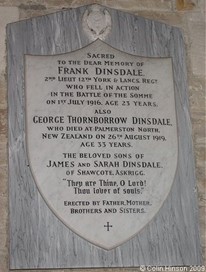
Frank had been a favourite with both his brother officers and the men of his battalion and several of them spoke in high terms of his gallantry. The vice chairman of Leeds University had also testified to the esteem in which he was held by his college friends. When on leave, he had said to his family that if he was called to yield his life, they must not lament but ‘rather feel proud that it was for his country and his king that he had died.’
Frank is buried in Grave C20, Queens Cemetery, Pusieux, a village 15 kilometres north of Albert.
At least 5 of Frank’s siblings had emigrated to New Zealand before the first world war, Isabel, Ellen and Owen left in 1911; and John and George also found work farming in New Zealand. George died there three years after Frank. Their heartbroken parents had a memorial plaque put up in St Mary’s Church in Hardraw. Robert, Thomas and James remained in the UK as well as sisters Elizabeth and Frances.
Private John William Horn, 4th Battalion, Yorkshire Regiment
John Horn’s father, Jeremiah, was born in Preston under Scar, near Leyburn and he married Margaret who was also from Leyburn and in 1900 the family moved to Burtersett, where Jeremiah had a job as a stonemason and hewer of rock at Burtersett quarry. Their three children John, Anthony and George had all been born in Leyburn.
John, who was working at the quarry like his father, enlisted at Askrigg in October 1915, joining 4th battalion Yorkshire Regiment. He married a local girl Jane Ann and by the time of his death in September 1916, a child, Margaret, had been born.
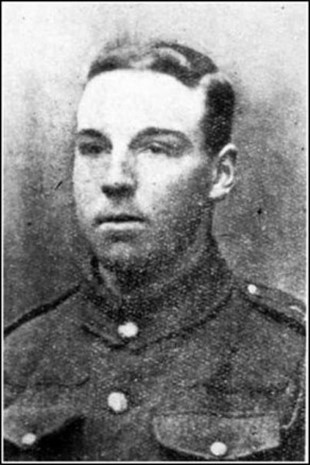 Embarking for France in April 1916 the battalion was not called upon to take part in the Battle of the Somme until 15th September, when the attack supported by tanks began. The battalion held the line for the next two days under heavy shellfire which caused many casualties. Soaked through and exhausted they were relieved on September 19th.
Embarking for France in April 1916 the battalion was not called upon to take part in the Battle of the Somme until 15th September, when the attack supported by tanks began. The battalion held the line for the next two days under heavy shellfire which caused many casualties. Soaked through and exhausted they were relieved on September 19th.
The plan for September 26th was to attack and capture the German trenches running from Flers. The battalion were to attack at 11:00pm in conjunction with the 5th Durham Light Infantry but, by mistake, the Durham’s did not attack, and the 4th battalion found themselves in the German trenches with both flanks exposed and were driven out by strong counterattacks on September 27th. The losses were large and during the German counterattack, John was killed.
He was posted as missing, and it was not until early 1917 that Jane was notified that her husband had been killed. His name is the Thiepval memorial
Jane and her daughter Margaret lived with her parents-in-law after John’s death and on the 1921 census, the extended family is still living together in Burtersett. Jane remarried in 1931 to Thomas Christopher ‘Kit’ Calvert.
His brothers, Anthony and George, both married and took up farming, leaving Wensleydale. Anthony and Mary farmed near Harrogate and George and Alice at Gibraltar Farm in Lancashire.
Private James Kirkbride, 3rd Battalion Essex Regiment
Thomas Kirkbride, a cattle dealer born in Gayle, near Hawes married Margaret Terry from Askrigg in 1890. The couple and their expanding family lived in Worton for a number of years before moving to Town Head Farm in Askrigg. They had 13 children – Frederick, Thomas, Mary Elizabeth, Annie, James, Ernest, Esther, John (known as Jack) William, Margaret, Henry, Agnes and Laura.
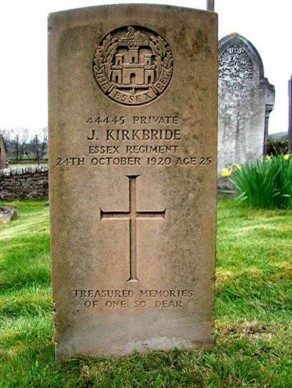
All four older boys fought in the WW1 and all survived the war but sadly Jim, as James was more commonly known, was severely affected by a gas attack on the Western Front, when serving with the Essex Regiment. He was returned to England, still suffering badly from the effects of the gas and was in a convalescent home, in the Durham house provided by prime minster, Anthony Eden’s mother.
Jim died on 24th October 1920 aged just 25 and was buried in the churchyard of St Oswald’s church.
Also buried in the churchyard are Jim’s sister Esther, who died in 1919 and brother Jack who died in 1927 aged 26, less than a year after his marriage to Agnes Robinson.
All his remaining brothers farmed in and around Wensleydale – Frederick in Countersett, Thomas, William, Ernest and Henry in Askrigg. The family still farm in Askrigg today.
The Kirkbride family were dealt another blow during the second world war, which claimed the life of Sidney Chapman Kirkbride, the eldest son of Jim’s brother Thomas
Bernard Grime Lodge, Second Lieutenant Durham Light Infantry
Bernard Grime Lodge was the only child of solicitor John James Grime Lodge and his wife Sarah Ann Preston. John was born in Hardraw, the eldest son of Thomas Lodge, who was at the time of John’s birth, the Vicar of St Margaret’s in Hawes. Sarah was the youngest child of John Preston and Elizabeth (Graham), who farmed in and around Askrigg. The couple married in Blackburn on 23 April 1893 and Bernard was born the following year on 23 March 1894.
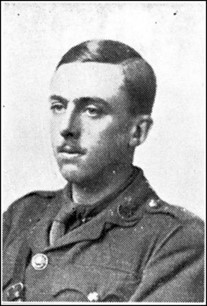
Bernard was just 3 when his mother died, and he and his father went to live with Anne and William Balderstone at Yorebridge. Anne was John’s older sister, and she was married to schoolmaster William Balderstone. He attended the Yorebridge Grammar School and then Giggleswick School before beginning a career in banking with Barclays Bank. He was also related to the Reverend Christopher Whaley (vicar at Askrigg), who was married to his aunt Agnes. In 1914 he enlisted in the 19th Universities and Public Schools Battalion, The Royal Fusiliers aged 20. He embarked for France with the British Expeditionary Force and returned to England later to join an Officers Cadet Force. He obtained a commission in August 1916.
He returned to France, attached to the 10th Battalion of the Durham Light Infantry and he was the Battalion Bombing and Intelligence Officer. Bernard died at Inverness Copse on 24 October 2017, during the battle of Ypres.
His commanding officer wrote to Bernard’s father:
‘It is with the deepest sympathy that I write to tell you of the death in action of your charming boy, who was my intelligence officer. A braver, cooler and more reliable officer could not be found. He had done wonderfully gallant work on patrol on numerous occasions and whatever the job he had to do, I could absolutely rely on his doing it thoroughly. I know no other officer in the Battalion I could have spared less than he. He was brave as a lion. We were counter-attacked at 4.30am on 24th and I turned out all the men at HQ. He, without any orders, dashed off with the leading men right up to the front where danger threatened. I don’t know how I shall replace him as not only was he valuable as an officer, but I was very fond of him, as were we all.’
He was mentioned by Sir Douglas Haig in dispatches for his gallant and distinguished service.
Second Lieutenant Bernard Grime Lodge is commemorated both here, and at the Tynecot Memorial in Flanders (panel 28).
Bernard’s cousins John and James Preston, sons of Sarah’s brother James, were also both involved in WW1. Whilst John survived and returned to his wife Lizzie (who was also a cousin of Bernard and John through Sarah and James’ sister Margaret!) his younger brother, James, died just over a week after Bernard following wounds sustained in battle aged just 20.
Driver John James Metcalfe, Royal Army Service Corps and Labour Corps
Of all of the names of the WW1 memorial, John is the one we know least about. This is partly because the Metcalfe name is relatively common in Wensleydale, and that on all the memorials and paperwork, there is only one name given – John is listed as the son of M A Metcalfe.
Investigation gives the following as the likely family of John James – if anyone can confirm or add to this, we would love to hear from you. His great grandparents were James Metcalfe and Mary Cockfield, who farmed in Woodhall. James died in 1845 after just five years of marriage, leaving Mary to manage the farm and two young children, Jane and James. Jane was born in 1842, and in 1863 she gave birth to a daughter Mary Alice, who would become the M A Metcalfe mentioned on John’s paperwork. Mary was brought up at the farm with her grandmother, mother and uncle but when her mother married stonemason Jeffrey Miller in 1879, Mary remained on the farm with her grandmother, while Jane and her husband lived in Hawes with their growing family.
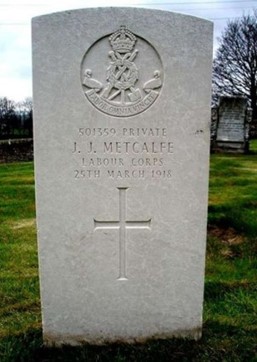
Mary became the mother of three illegitimate children – Mary Jane, Elizabeth and John James. She lived initially in Worton, working as a charlady to bring in some money. The family later moved to Main Street, Askrigg where Mary worked as a laundress. John was born early in 1896 and enlisted in the army on 19th February 1915 at Leyburn recruiting office aged 19. He was sent out to Egypt just 5 days later as part of the Expeditionary Force but was admitted to hospital in Alexandria suffering from dysentery in September 1915. He was sent back to England to continue his recovery. Whilst fit enough to remain in the army, he remained in the UK and was transferred to the Royal Army Service Corps.
In December 1917 he was admitted to the army hospital suffering from chest problems and weight loss. Tests showed he was suffering from tuberculosis affecting the lungs and he remained in hospital until 28th February 1918. He was discharged from the army on 21st March 1918 and his discharge papers state that his condition was 100% attributable to his army service in Egypt and Gallipoli. It was recommended that John be placed in a sanitorium after his discharge, however he died just 4 days later and was buried in the churchyard in Askrigg.
If the records are interpreted correctly, John’s elder sister, Mary Jane, married Robert Mudd, another name on the WWI war memorial.
Rifleman Robert Pickering Metcalfe, 8th Battalion, Kings Royal Rifle Corps
Robert was born in Thornton Rust in the summer of 1893, the youngest child of George Metcalfe and Grace Pickering. George was a farmer, born in nearby Bishopdale who married Grace in 1884. The couple had seven children, 4 boys and 3 girls. Robert worked on the farm, but during the war enlisted in Leyburn was posted to 8th Battalion, KRRC.
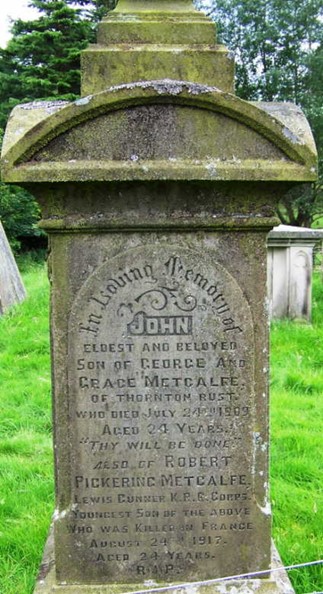
On 22 August 1917, Robert’s battalion were in Sanctuary Wood near Ypres, close to the position occupied by Bernard Grime Lodge, another soldier on the War Memorial. They were being heavily shelled and had lost 50 casualties. As they were about to be relieved on 24th August, an SOS signal went up, indicating a German counterattack near Inverness Copse, where the battalion was pinned down.
The counterattack was a failure, except on the left, where a few patrols pushed through, but they did not get very far. During the day, the 8th Battalion had to withdraw from the Copse and suffered severe casualties from shell fire, losing six officers and 100 casualties from other ranks. Robert was one of those killed, the first soldier from Thornton Rust to die in action. Rifleman Robert, along with a party of 10 others, were ordered to storm the front line of the enemy’s trenches, when a shell burst amongst them, causing the death of all but two who were severely injured.
His Captain wrote in a letter to Robert’s mother, ‘Your son has done extremely good work out here as a Lewis gunner and his death is greatly deplored by all of us’. Robert’s name is commemorated on the Tyne Cot Memorial.
George and Grace had lost their eldest son John in 1909 and had now lost a second. Before their own deaths in their 80s, another son, Thomas would die in 1938 and a memorial to their three sons and to Grace and George is in the churchyard of St Andrew’s Church in Aysgarth. Their remaining son, George (1888-1970) married Martha Slinger Dinsdale in 1915. As for their daughters – Mary Alice (1887-1975) married Askrigg farmer Ralph Tiplady Metcalfe in 1914, whom she got to know when her brother Robert worked for him in 1911; Elizabeth (1889-1975) married dairy farmer Thomas Tennant of Worton Hall, and Anne Margaret (1890-1972) remained at home looking after her widowed father and after his death married Joseph Lambert North in 1946.
Private Thomas Miller, 10th Battalion, East Yorkshire Regiment
Thomas was born in Woodhall in 1899, the middle son of George Coates Miller and his wife, Margaret (nee Holmes). George farmed in Woodhall and had married Margaret, from Carlton in Coverdale in 1894. They had three sons – John (known as Jack), Thomas and James and three daughters, Margaret, Alice Henrietta and Mary Elizabeth.
Jack and Thomas worked with their father on the farm, with Jack enlisting in January 1916 and being posted overseas with the West Yorkshire Regiment in June 1916. Jack was posted missing on 5th September 1916 but was found and taken to the field hospital with a gunshot wound to the chest. He was transferred by to England but recovered sufficiently to return to the front in January 1917.

In February 1917, Thomas enlisted in Richmond and also to the West Yorkshire Regiment. With them, he embarked for France in October 1917 and fought in the Battle of Cambrai. On Christmas Day, he was taken to the General Canadian Hospital in France suffering from severe boils and was eventually transferred back to Carlisle on 12th January 1918. From there he was able to spend some of his convalescence time with his family. Skin problems were common in the trenches because of the terrible cramped and wet conditions. His brother Jack was admitted to hospital later in the war with scabies.
Thomas returned to France and was drafted into the 10th Battalion, East Yorkshire Regiment and from 26th to 31st March was heavily involved in stopping the Ludendorff Offensive in an area to the northwest of Bapaume. When the second thrust of the Offensive began on 9th April, Thomas’ battalion was in the vicinity of Armentieres, on the northern side of the river Lys and was engaged in fierce fighting.
On 13th April, Thomas was badly wounded having sustained serious injuries to his spine and he was paralysed. He was sent to a hospital in Etaples, where he died from these wounds on 17th April. He is buried in grave XXIX E.9 in Etaples Military Cemetery. The matron of the hospital wrote to his mother, Margaret, telling her that he suffered no pain, as much of the time in the hospital he was unconscious. He had wanted for nothing and was well tended by the British nurses.
A memorial service was held in St Oswald’s the Sunday after his death. In his tribute, Revd Squibb said that he had met Thomas just a few weeks earlier when he had been on leave and he had been walking down the road ‘full of vim and vigour, with the usual cheery smile on his face’. He added that Thomas had been ‘a bright, loveable lad’ and that his heart went out to his parents.
His brother Jack (1896-1980) returned from the war and eventually took over the running of the family farm from his father, with the help of younger brother James (1900-1975), who had been too young to enlist and who never married. Margaret (1894-) and Mary Elizabeth (1904-1995) never married either and also remained on the family farm. Alice Henrietta (1902-1985) married neighbour James ‘Jimmy’ Alderson, a garage owner in 1925.
Private John Mitton, 2nd Battalion, Yorkshire Regiment
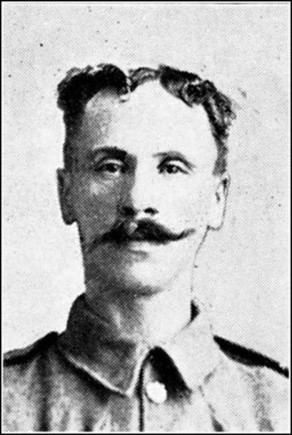 John Mitton, born in 1877, was the eldest son of Warrin and Ellen Mitton (nee Atkinson). Warrin was a joiner and farmer, born in Askrigg, but settled in Hawes with his Sedbergh born wife. The couple had three children, John, Nancy and Thomas. John initially worked with his father on the farm, but then became a postman. He married Mary Teresa Frost in 1905 and worked for a while in her home village of Finghall and the surrounding area. When he left to move to the Askrigg, the residents of Finghall clubbed together to buy him a marble clock and a pipe together with a purse containing cash as a leaving present, which must show the regard in which he was held.
John Mitton, born in 1877, was the eldest son of Warrin and Ellen Mitton (nee Atkinson). Warrin was a joiner and farmer, born in Askrigg, but settled in Hawes with his Sedbergh born wife. The couple had three children, John, Nancy and Thomas. John initially worked with his father on the farm, but then became a postman. He married Mary Teresa Frost in 1905 and worked for a while in her home village of Finghall and the surrounding area. When he left to move to the Askrigg, the residents of Finghall clubbed together to buy him a marble clock and a pipe together with a purse containing cash as a leaving present, which must show the regard in which he was held.
The family – John and Mary and their two daughters Ellen (1906) and Mary (1908) – moved to Askrigg, where John continued to work as a postman. He played for many years for the Hawes football team and acted as their secretary for 2 years. He was also a fine billiards player. As a youth, he was a member of the St Margaret’s Church choir in Hawes, and later sang in the choir here in St Oswald’s. He was an outgoing man and had many friends.
John enlisted in Leyburn and joined the 2nd Battalion, Yorkshire Regiment, embarking for France at the end of July 1916. On 7th April 1917 the Battalion moved from Bellacourt to Blairville, south of Arras, ready for the start of the Arras Offensive scheduled for the 9th. They followed the first wave to mop up the open ground until held up by the German wire. One party established itself in shell holes, joining them up by digging trenches during the day and here they remained under shell and rifle fire until relieved at 1am on 10th April.
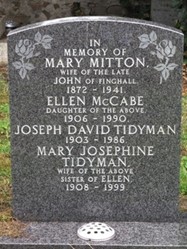
John was one of 24 killed – a further 89 were wounded and another two missing presumed dead. He was buried in Grave D15 of the Neuville-Vitasse Road Cemetery, 6 miles SE of Arras. John’s brother Tom had joined up around the same time as his brother and was in France at the same time with the Royal Field Artillery. Fortunately, he survived the war and returned to his wife and home in Liverpool. Their sister, Nancy Metcalfe Mitton remained unmarried and died in Hawes in 1946 aged 65, leaving her estate to John’s eldest daughter, Ellen.
John’s wife Mary did not re-marry and, after her daughters left home, lived for a while with her unmarried sister, Lucy, in Lancashire, where she died in 1941.
Daughters Ellen and Mary both married in Leyburn in 1931, with Mary marrying a dairy farmer, Joseph Tidyman, and Ellen, a draper, Joseph McCabe. All three are buried in the Roman Catholic churchyard at Ulshaw Bridge near Middleham.
Company Sergeant Major Robert Mudd, 10th Battalion, West Yorkshire Regiment
Born in Ripon in 1881, Robert was the son of Edward Mudd and Margaret (nee Casey) of Masham and the husband of Mary Jane Metcalfe. He came from a large family, having had 12 siblings. He joined the army aged 18 in 1899 and went through the Boer War in which he was wounded. He held the South African medal 1901 to 1902 with five bars -Laing’s Neck, Transvaal, Relief of Ladysmith, Orange Free State and Tugela Heights. His elder brother Edward was also in the army and fought in South Africa. He was, however, invalided out in early 1902 and died in 1907.
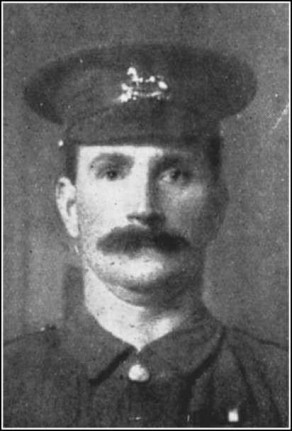
Following his time in the army, Robert became a stone mason. Early in January 1912, he married Mary Jane Metcalfe here in St Oswald’s Church. Mary had lived in Main Street with her mother and brother for all her life, and had a child, James, who was born in 1910. The couple continued to live in Askrigg and had two boys of their own, Edward born on 13 August 1912 and Leonard, 11 April 1915, both baptised in the church.
When war was declared he was in the second reserve and his time would have expired in November 1914. He was one of the first to be called to the colours and left his wife and three children in Askrigg to enlist in York, where he joined the 10th battalion West Yorkshire regiment. He acted for some months as a drill instructor but was sent to France on 12th July 1915 and remained there until December of that year, when he claimed and obtained his discharge. He resumed civilian life, being employed by G Dougill and Son contractors of Aysgarth.
Robert was called up again on 28th June 1916, just six months later and was sent to back France six weeks after that, where he was joined in the battalion by two of his brothers. In total three of his brothers fought in WWI. On 13th April 1917 during the battle of Arras, the battalion was in the vicinity of Monchy-le-Preux, just to the east of Arras. All day long the enemy, assisted by air support, heavily shelled the frontline trenches and casualties were severe.
Robert and two officers in who were in close proximity were all killed when a shell dropped onto their position. He has no known grave, but Robert’s name is found on Bay four of the Arras Memorial.
Of Robert’s siblings, married carter, James (1875-1903), invalided soldier Edward (1877-1907), stone mason John (1878-1908), Margaret Ellen (1885-1904) and Frederick (1891-1907) had all died before world war one.
All three of his brothers also fighting – Francis, George and Joseph – returned safely. Francis (1883-1959) was a platelayer and had signed up in June 1916 and was in the Royal Garrison Artillery. George Henry (1889-1949) was a quarryman and signed up in September 1915 and was with Robert in the Yorkshire Regiment. Joseph (1895-1977) was the first of the brothers to join up in August 1914. He was wounded a couple of times during the course of the war, but fortunately received only minor injuries and he was promoted to corporal towards the end of the war. On demobilisation he became a farm foreman.
Of his other siblings – Sarah Ann was born in 1893; Christopher (1897-1927) joined the army for a short spell before being medically discharged and married Mary Jane’s sister, Elizabeth here in Askrigg in 1918. After the war he was a forester. Youngest brother Leonard (1901-1985) became a shepherd.
Robert’s widow, Mary Jane, married Richard Heslop in 1919. His son Edward married Gladys and worked in the Steel Industry. His youngest son, Leonard, worked as a quarryman and in 1939 was living with his widowed aunt Elizabeth.
Private James Graham Preston, 18th Battalion, Lancashire Fusiliers
James was the son of Askrigg farmer James Preston and Margaret Ann (nee Chapman) who lived at West End House in Askrigg. James and Margaret had five children, 4 sons and 1 daughter.
Their eldest son Charles (1882-1914) went to Liverpool before the Great War to run one of the milk houses but died just as the war began. He was married and had four children. Another son, John, (1883-1948) known as Jack, also went to Liverpool and married Lizzie Preston Banks, who died shortly after giving birth to their only child, Constance Margaret, born in 1910. Jack brought his daughter home to Askrigg where he worked on the farm. He enlisted in the army in 1915 and didn’t return to Askrigg until April 1919. He fought at Gallipoli and in Egypt, returning home to West End House, where he died in the 1940s. He was the founder of ‘The Gallipoli Association’.
James and Margaret’s only daughter Isabel (1893-1974) married John Tiplady Leyland, a grocer, in 1919 and they lived in Bainbridge. Youngest child, Frank, followed his brothers and father into farming; although he moved with his wife Jean Mearns to Easingwold where he kept a dairy herd.
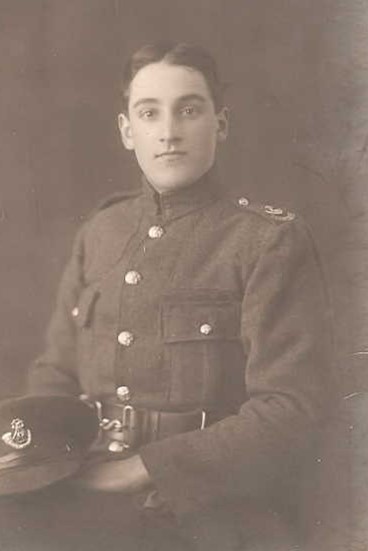
Middle son, James Preston, or Jim as he was commonly known, was in training at Becketts Park College, Leeds to become a teacher with his cousin Dick Chapman also from Askrigg. Jim had won two medals and a certificate for swimming and beat the five-mile junior college record for running, doing the distance in 32 minutes and 30 seconds. He was a member of Askrigg church choir and a Sunday school teacher for several years. He had been a pupil teacher at Askrigg day school. Jim volunteered for the army whilst at Leeds in 1915 and joined up in 1916, going to France in January 1917. He first joined the Royal Field Artillery but later transferred to the 18th Battalion Lancashire Fusiliers, where he became a bugler.
He twice refused a Commission, preferring to serve as a private. On his 20th birthday, the 22nd of October 1917, the battalion took part in the attack on Houthulst Forest in the Ypres Salient, pushing forward but receiving heavy casualties. Some concrete bunkers occupied by the Germans had not been dealt with and machine gunfire from them caused numerous casualties all day.
The battalion was in a very exhausted state owing to the heavy and broken ground. Many of the men had lain all day in shell holes up to their waist in water. A number of wounded were brought in who had been left out during daylight owing to the continual sniping by the Germans. One of these wounded fusiliers was Jim, whose lung had been pierced by a bullet and he was transferred to the vast hospital complex at Wimereux on the coast north of Boulogne.
Jim had returned to France six weeks before his death, after spending 10 days leave at home. He wrote to his cousin Dick at Wharton House in Askrigg just two days before he died. He wrote:
Dear Dick, I don’t know whether you are at home but still am dropping you these few lines to let you know that I am still going on alright. I suppose you will have got the news that I am wounded in the back – a birthday present it was. I am now in No 4 Gen Hospital No 1 Ward, No 3 bed and am having a pretty good time – if it wasn’t for having to lie in bed all day and in pain every time I move, everything would be A1. We are on the sea front, and I can sit in bed and look out the window watching the waves and the boats going across to Blighty. I hope to be on one of the latter soon and shall try to get to Beckett’s Park Hospital if it can be done. Well the best of luck. Yours sincerely Jim. PS excuse weak letter, am not in form for letter writing
The matron from the hospital wrote to Jim’s parents: ‘your boy died at 11:30am this morning. All day yesterday, he was becoming gradually worse and when I saw him this morning, I felt he could not last long. He was perfectly conscious then and when I asked him how he felt he said I am rather weak. I told him I would write to you today and he said, send my love and remember me to all my relatives. I am so very sorry; he was such a sweet boy.’
Jim had written home every day after he was wounded, right up to the 31st of October and he died on 2nd November. He is buried in grave V1 F 21 at Wimereux communal cemetery. During 1917, Jim and 24 other Wensleydale men were killed or died as a result of actions in the Ypres Salient.
Jim’s cousin, Dick Chapman, to whom he wrote the letter, was the son of his mother’s brother Azariah. He completed his teacher training and worked in Bingley. He returned to Hawes in later life.
Gunner William Hunter Tomlinson Webster, Z 57th Trench Mortar Battery, RFA
William’s parents were John Anthony Webster, born in Barningham, a little south of Barnard Castle and his wife, Jane Stockdale. The couple married here at St Oswald’s in 1874 and lived at Nappa Scar, with John farming the land around their home. They had a large family Matthew (1875-), Elizabeth (1877-), Sarah Ellen (1879-), John William (1881-1956), Mary Jane (1883-1961), Christopher Tomlinson (1855-1959), Thomas Edward (1886-1935), Samuel Stockdale (1888-1922), Dora Stockdale (1890-), Hannah Jane (1892-196) and William was the youngest, born in 1895.
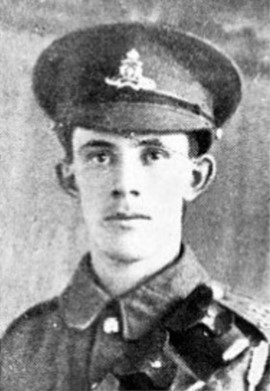
As a youngster, William worked on his father’s farm and was a member of the church choir in Askrigg. He was working for a dairy in Liverpool when he enlisted in the army in May 1915, aged 19. His brothers Thomas and Samuel also enlisted in the army.
Although Thomas and Samuel survived, in August 1917, William’s parents received the news that William had died in hospital in France.
He was a gunner in a trench mortar battery and had been in France since December 1916. He had been slightly wounded on 7th July, but on the night of 29th July, his billet was heavily shelled with gas canisters. He assisted his comrades who had suffered more than himself and afterwards was taken to one of the military hospitals in the base at Etaples, 27km south of Boulogne. William’s condition deteriorated and he developed pneumonia from which he died on 5th August. He is buried in Grave XX11.0.21A in Etaples Military Cemetery
Of William’s sisters – Elizabeth married John Thompson and Sarah married Matthew Wells both of whom were farmers. Mary Jane was widowed shortly after her marriage to John Guy and was left with two young sons. Dora married gardener William Metcalfe and Hannah married cowman John Allison. William’s brothers all were connected with farming, Christopher married Georgina, Thomas married Annie and Samuel, Mary Gibson.
